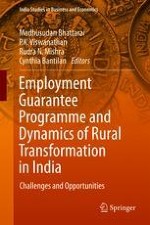2018 | OriginalPaper | Buchkapitel
10. Inter-sectoral Linkages and Multipliers of MGNREGA in a Rainfed Village in Karnataka: Applications of Social Accounting Matrix (SAM)
verfasst von : Gourav Kumar Vani, P. S. Srikantha Murthy, Madhusudan Bhattarai
Erschienen in: Employment Guarantee Programme and Dynamics of Rural Transformation in India
Verlag: Springer Singapore
Aktivieren Sie unsere intelligente Suche, um passende Fachinhalte oder Patente zu finden.
Wählen Sie Textabschnitte aus um mit Künstlicher Intelligenz passenden Patente zu finden. powered by
Markieren Sie Textabschnitte, um KI-gestützt weitere passende Inhalte zu finden. powered by
